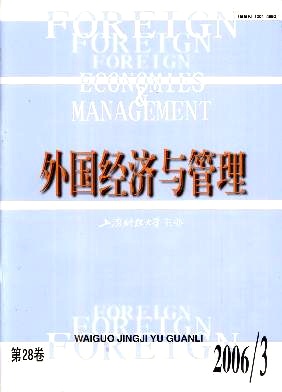银行卡产业规制研究探析
外国经济与管理 2006 年 第 28 卷第 03 期, 页码:52 - 58
摘要
参考文献
摘要
银行卡产业是典型的具有“双边市场”特征的产业,对银行卡产业进行规制不能简单地运用传统“单边市场”的规制理论来解释。本文在探讨银行卡产业的运作机制及产业特征的基础上,对银行卡产业争议较大的禁止额外收费、交换费和银行卡组织竞争的规制进行了述评,以期对我国银行卡产业的发展有所启示。
[1]Krueger,M.Interchange fee in the line of fire[R].Institute for Prospective Technological Studies,Spain,2001:1-24.
[2]Chakravorti,S.How do we pay?[R].Federal Reserve Bank of Dallas Financial Industry Issues,1997:1-10.
[3]Chakravorti,S and A Shah.Underlying incentives in credit card networks[R].The Antitrust Bulletin,2003:1-22.
[4]Ernst and Young.Survey of retail payment systems[R].Chain Store Age,1996:1-41.
[5]Rochet,J and J Tirole.Cooperation among competitors:some economics of payment card associations[J].RAND Journalof Economics,2002(3):549-570.
[6]Rochet,J and J Tirole.Two-sided market:an overview[R].IDEI University of Toulouse,2004:1-34.
[7]Katz Michael and Carl Shapiro.Network externality,competition and compatibility[J].American Economic Review,1985(2):424-440.
[8]Roberto Roson.Two-sided market:a tentative survey[J].Review of Network Economics,2005(2):142-160.
[9]Schmalensee,R.Payment systems and interchange fees[J].Journal of Industrial Economics,2002(50):103-122.
[10]Katz,M.Reform of credit card schemes in Australia II[R].Reserve Bank of Australia,2001:1-79.
[11]Schwartz,M and Vincent,D.Same price,cash or card:vertical control by payment networks[R].Georgewown UniversityDepartment of Economics,2002:1-19.
[12]Wright,J.Optimal card payment systems[J].European Economic Review,2003(47):587-612.
[13]Chakravorti,S and W R Emmons.Who pays for credit cards?[J].Journal of Consumer Affairs,2003(4):120-126.
[14]Vis,E and J Toth.The abolition of the no-discrimination rule[R].ITM Research for Competition DG:Amsterdam,2000:1-9.
[15]IMA Market Development AB.Study regarding the effects of the abolition of the non-discrimination rule in Sweden[R].2000:1-24.
[16]Baxter,W F.Bank interchange of transactional paper:legal and economic perspectives[J].Journal of Law&Economics,1983,(26):541-588.
[17]Wright,J.The determinants of optimal interchange fees in payment systems[J].Journal of Industrial Economics,2004(3):1-25.
[18]Gans,J S and S P King.The neutrality of the interchange fees in the payment systems[J].Topics in Economic Analysis&Politics,2003(3):119-126.
[19]Rochet,J and J Tirole.Platform competition in two-sided markets[J].Journal of European Economic Association,2003(1):990-1029.
[20]Guthrie,G and J Wright.Competing payment schemes[R].University of Auckland,2003:1-23.
[21]Chakravorti,S and R Roson.Platform competition in two-sided markets:the case of payment networks[R].Federal Re-serve Bank of Chicago,2004:1-40.
[22]Hausman,J A,G K Leonard and J Tirole.On nonexclusive membership in competing joint ventures[J].RAND Journalof Economics,2003(34):43-62.
[2]Chakravorti,S.How do we pay?[R].Federal Reserve Bank of Dallas Financial Industry Issues,1997:1-10.
[3]Chakravorti,S and A Shah.Underlying incentives in credit card networks[R].The Antitrust Bulletin,2003:1-22.
[4]Ernst and Young.Survey of retail payment systems[R].Chain Store Age,1996:1-41.
[5]Rochet,J and J Tirole.Cooperation among competitors:some economics of payment card associations[J].RAND Journalof Economics,2002(3):549-570.
[6]Rochet,J and J Tirole.Two-sided market:an overview[R].IDEI University of Toulouse,2004:1-34.
[7]Katz Michael and Carl Shapiro.Network externality,competition and compatibility[J].American Economic Review,1985(2):424-440.
[8]Roberto Roson.Two-sided market:a tentative survey[J].Review of Network Economics,2005(2):142-160.
[9]Schmalensee,R.Payment systems and interchange fees[J].Journal of Industrial Economics,2002(50):103-122.
[10]Katz,M.Reform of credit card schemes in Australia II[R].Reserve Bank of Australia,2001:1-79.
[11]Schwartz,M and Vincent,D.Same price,cash or card:vertical control by payment networks[R].Georgewown UniversityDepartment of Economics,2002:1-19.
[12]Wright,J.Optimal card payment systems[J].European Economic Review,2003(47):587-612.
[13]Chakravorti,S and W R Emmons.Who pays for credit cards?[J].Journal of Consumer Affairs,2003(4):120-126.
[14]Vis,E and J Toth.The abolition of the no-discrimination rule[R].ITM Research for Competition DG:Amsterdam,2000:1-9.
[15]IMA Market Development AB.Study regarding the effects of the abolition of the non-discrimination rule in Sweden[R].2000:1-24.
[16]Baxter,W F.Bank interchange of transactional paper:legal and economic perspectives[J].Journal of Law&Economics,1983,(26):541-588.
[17]Wright,J.The determinants of optimal interchange fees in payment systems[J].Journal of Industrial Economics,2004(3):1-25.
[18]Gans,J S and S P King.The neutrality of the interchange fees in the payment systems[J].Topics in Economic Analysis&Politics,2003(3):119-126.
[19]Rochet,J and J Tirole.Platform competition in two-sided markets[J].Journal of European Economic Association,2003(1):990-1029.
[20]Guthrie,G and J Wright.Competing payment schemes[R].University of Auckland,2003:1-23.
[21]Chakravorti,S and R Roson.Platform competition in two-sided markets:the case of payment networks[R].Federal Re-serve Bank of Chicago,2004:1-40.
[22]Hausman,J A,G K Leonard and J Tirole.On nonexclusive membership in competing joint ventures[J].RAND Journalof Economics,2003(34):43-62.
引用本文
岳中刚. 银行卡产业规制研究探析[J]. 外国经济与管理, 2006, 28(3): 52–58.
导出参考文献,格式为:
上一篇:国外群体凝聚力研究评介
下一篇:壳牌公司利益相关者管理模式探析





 6363
6363  0
0

